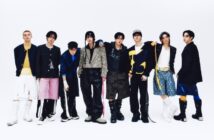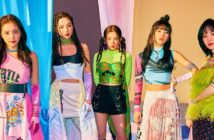
The Independent is the latest UK media to set the hearts of Kpop fans in the UK alight with another Kpop praising article published on their site. The Guardian too, has published about Kpop positively several times in the past, with it even making the front page of their newspaper, unlike other large news sites such as the BBC who still portray the Hallyu Wave negatively. Check out the article, and The Independent’s interview with SHINee below the cut!
The loudest screaming I’ve ever heard isn’t at a pop concert at the O2, or the Pyramid stage at Glastonbury, or the Birmingham NEC – it’s ringing up and down the aisles of a cinema in central London. And the cause of such eardrum-shredding shrillness? Not stadium rock gods or Simon Cowell’s latest pop puppet or a Beyoncé-calibre diva, but a band you’ve probably never even heard of: SHINee, five pretty young men from Korea. This is K-pop, and it may just be conquering the world.
SHINee – pronounced ‘shiny’ – have come to the UK as part of the Korean Film Festival, which explains the unlikely venue of the Odeon in Leicester Square. Initially I’m a little sceptical of just how big this K-pop craze really is – a doubt which evaporates on spotting excitable teens clutching homemade signs on the Tube, a queue snaking round the building and, inside, an extraordinary level of pent-up excitement.
SHINee have filled stadiums as large as the 55,000-seat Tokyo Dome in September, and helped sell out a K-pop showcase in Madison Square Gardens last month. No wonder Odeon reported that the demand for tickets crashed their website just one minute after they went on sale – and it remained down for five hours.
Inside, the atmosphere is feverish, and heavy with hormones. The fans – mostly teenagers, almost entirely girls – brandish camera phones with furious focus, and modulate the intensity of their shrieks as each boy-singer appears onstage. Sixteen-year-old Andi Ankala from Aylesbury earnestly informs me, “This is going to be the best hour of my life”.
The audience is astonishingly well behaved: an organiser tells them at the start that they must remain in their seats and on no account stand up, and this is scrupulously obeyed – arms and glow sticks are flung in the air with wild abandon, but their tiny teenage bums remain firmly on seats.
So K-pop may get the girls a-flutter, but it ain’t exactly rock’n’roll. This is entirely fitting: the level of brand management that goes into K-pop groups makes Syco [Simon Cowell’s company] look like an underground punk collective. Companies such as SM Entertainment – who signed SHINee and other hugely popular groups such as Super Junior and Girls Generation – develop the talent from a young age, grooming their singing, dancing and looking-cute-in-tight-trousers skills. Think X Factor bootcamp, but going on for years.
Speaking to SHINee post-gig about this training, band member Jonghyun explains “everyone went through the casting and auditions phase to get into SM Entertainment. Most people started from high-school ages; Taemin actually started from elementary [primary]school age.” They certainly start them early – and Taemin, a young man of disconcertingly feminine beauty, is still but a tender 18 (his band mates are also all shy of 22).
The result of this training is a slick, sharp, slightly soulless pop machine. Their dance routines – notionally sexy, with hipthrusts and pouting – remain curiously sanitised, if perfectly executed. Their singing voices are good, and while the songs are mostly in Korean, there’s a fair smattering of English in their lyrics (“Hello, hello!” “Super crazy!”).
Most K-pop bands also perform in Japanese, to capitalise on – and potentially cannibalise – the J-pop market in Japan, the equivalent genre of equally synthetic music. Musically, K-pop hits most successful chart trends: it’s bubblegum pop with hip-hop inflections, driven by electro dance beats and with an R&B-slick production finish. And it’s catchy – very, very catchy. Having listened to a few tracks on YouTube in prep, I’m surprised to find much of their set is bouncingly familiar.
Never has a band had such an appropriate name: strutting around onstage, SHINee are extremely shiny. Their hair is shiny, their black leather jackets and slim blazers are shiny, their blinging chains and necklaces are shiny – even their Doc Martens, surely destined never to be scuffed in a mosh pit, are shiny, shiny, shiny.
Style is a big part of K-pop; Jonghyun, the most chatty of the group, comments that “we always aim to start a new trend, and we study fashion and always try to change the fashion for ourselves as well as for other people… we want to be like a rainbow!”. While there’s plenty of moody-teen black on show today, they’re also fond of splashes of leopard print and tartan – but this is all gothic-lite, styled to within an inch of its life and worn tight enough to showcase SHINee’s skinny frames.
Lela Mamma, aged 16, from London, tells me that their look is part of their appeal: “I’ve always liked Asian-oriented things, the style, the dancing, the actual music, it’s so cool – and the culture interests me too. There’s a range of looks within K-pop, but I think it’s the way the guys and girls look themselves: they’re really beautiful.”
The K-pop style may be a crucial part of the movement, but it is also a fast-moving thing: a Google image search for SHINee reveals how they flit between punkish torn skinnies to preppy pastel blazers to disco-tastic metallic jeans and space boots. And in the world of K-pop, SHINee are actually at the more restrained end. They have a manageable line-up of five performers – some groups stretch into double figures.
2PM are seven boys who like to get their biceps and pecs out; Girls Generation are an extremely cute, perky nine-piece girl group who dress in matchy-matchy outfits; Super Junior, an overwhelming, 13-strong troupe of spiky-haired male pop poppets. A carefully nuanced balance of toned, taut, teasing sexuality, and super-sanitised sugar-pop innocence seems to be a feature of the phenomenon; as Taemin tells me, “that’s our charm – to be young and cute as well as sexy. It shows our true colours.”
It’s an approach which has, of course, long stood British and American boy bands and girl groups – from N Sync to the Spice Girls to One Direction – in good stead too. And it’s not exactly like the West has slowed down in its churning out of attractive young popstrels – so why the interest in K-pop over here? While there were Korean ex-pats in the Odeon audience, they were probably in the minority. One young man had even travelled all the way up from Cornwall on a coach – a 16-hour round trip for one hour of concert. Why? And how did he find out about them in the first place?
“SHINee are one of my favourite groups ever; they’re like, top three – I’m really, really excited, but really tired as well!” explains the 18-year-old, Toby Collins. “I came on my own – there’s one other person I know near me [who likes them]but she couldn’t come. I’ve converted a few people to K-pop, other people are just like, ‘What?’ I found K-pop through a random blog, someone posted a Four Minute (a girl group) video, and I watched that and really liked it, and it just went from there.”
Ah, yes, the internet. Most fans I speak to stumbled on a K-pop video, and then it’s easy through YouTube, Twitter, Facebook and the bands’ own websites to find plenty more. The worldwide web allows for worldwide domination, and the K-pop-pushing labels have got it sewn up. Google are reportedly about to launch a dedicated YouTube K-pop channel.
It’s a tactic the band themselves are alive to: “The internet is very important to meet fans, especially foreign fans, through clips and videos,” explains Jonghyun. “We also use the site me2day – it’s a Korean sort of Twitter – and we meet a lot of fans through that.” Key added that, for them, You Tube and Facebook are “the best way to get the fans’ reactions and hopefully connect with other fans.”
But the internet hasn’t just connected consumers – sorry, discerning listeners – to new music, it’s also connected a lot of the kids in the audience with each other. Friends sitting together had first found each other, online, through their shared love of K-pop.
“I found out about [SHINee] through the internet, and I met friends through the internet and we got together and we share music tastes,” explains Rebecca Pattison, aged 17, from Dagenham, who adds, “I’ve been into K-pop for about three years; I was interested in the language and I heard about the music, and music is like a universal language.”
Sarah Yates, a 20-year-old from London, is watching with her Korean classmates: she signed up for free language classes at the Korean Cultural Centre in the capital after getting into K-pop, and now a gang of them run their own blog as the ‘Korean Class Massive’. Her classmate Tamana Sudika attempts to explain SHINee’s particular appeal, though she seems to be about to bubble over with excitement: “SHINee are amazing – one word, amazing! Their dancing… their songs… everything is amazing about them.”
Most of the British public may not yet share her enthusiasm, but be warned: as SHINee – and their fellow K-poppers – hawk their doe-eyes-and-tight-denim looks and their all-singing, all-dancing teen-appeal across the globe, the screams seem likely only to get louder.
Check out the full article with photo gallery here.
Newspaper scans (Credit: @Janviix):




